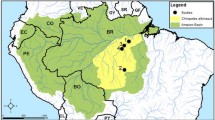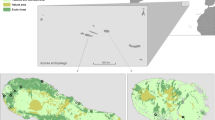Summary
Predation by red-winged blackbirds Agelaius phoeniceus L. on 13-year periodical cicadas (Magicicada spp.) and reactions by periodical cicadas to predators were studied during emergence of Brood XIX during summer of 1985 in northwestern Arkansas (USA). Emergences of periodical cicadas are classic examples of predator satiation due to high local densities of cicadas and birds are the major predators of adult periodical cicadas. Reactions of periodical cicadas to predators were assessed by recording behaviors exhibited by cicadas when approached in trees by a human hand during the 3-week period of peak adult densitics. Most male cicadas made a noise in association with escape behaviors when approached, and 50% of the females, which are silent, attempted escape behaviors. Observations of predation attempts on cicadas by red-winged blackbirds were made during the period of peak predation pressure. Red-winged blackbirds spent less time searching for cicadas over that 2-week period of increasing predation pressure, and became increasingly efficient at capturing cicadas. Handling time of cicadas by red-winged blackbirds increased by about 20 seconds over that period, as blackbirds spent more time consuming female cicadas. The flysquawk response, used only by male cicadas, was effective in deterring red-winged blackbirds; only 5% of the attacks by blackbirds were successful when that behavior was exhibited. All cicadas that remained motionless and silent when approached by blackbirds were captured and consumed. Because females remained inactive when approached more often than did males, blackbirds may have consumed more female cicadas. Changes that appeared in reactions of preiodical cicadas to the model predator and to the attacks of blackbirds reflect both changes in the sex ratio of the cicada populations and changes in behaviors of cicadas associated with mating and egg laying. The loud noise made by male periodical cicadas at mating centers did not appear to deter predation by blackbirds. Changes in the behavior of blackbirds that appeared to be in association with greater predation on female periodical cicadas relates directly to aspects of foraging theory, particularly predictions concerning more selective foraging during periods of abundant food resources.
Similar content being viewed by others
References
Alexander RD, Moore TE (1962) The evolutionary relationships of 17-year and 13-year cicadas, and three new species (Homoptera, Cicadidae, Magicicada). Misc Publ Mus Zool Univ Mich 121:1–59
Allard HA (1937) Some observations on the behaviour of the periodical cicada Magicicada septendecim L. Am Nat 71:588–604
Beamer RH (1931) Notes on the 17-year cicada in Kansas. J Kan Entomol Soc 4:53–58
Brown JJ, Chippendale GM (1973) Nature and fate of the nutrient reserves of the periodical (17 year) cicada. J Insect Physiol 19:607–614
Dunning DC, Byers JA, Zanger CD (1979) Courtship in two species of periodical cicadas, Magicicada septendecim and Magicicada cassini. Anim Behav 27:1073–1090
Dybas HS, Davis DD (1962) A population census of seventeen-year periodical cicadas (Homoptera: Cicadidae: Magicicada). Ecology 43:432–444
Forbush EH (1924) Gulls and terns feeding on the seventeen-year cicada. Auk 41:468–470
Högstedt G (1981) Effect of additional food on reproductive success in the Magpie (Pica pica). J Anim Ecol 50:219–229
Howard WJ (1937) Bird behavior as a result of emergence of seventeen year locusts. Wilson Bull 48:43–44
Kallander H (1981) The effects of provision of food in winter on a population of the Great Tit Parus major and the Blue Tit P. caeruleus. Ornis Scand 12:244–248
Karban R (1982) Increased reproductive success at high densities and predator satiation for periodical cicadas. Ecology 63:321–328
Karban R (1983) Sexual selection, body size and sex-related mortality in the cicada Magicicada cassini. Am Mid Nat 109:324–330
Korpimaki E (1984) Population dynamics of birds of prey in relation to fluctuations in small mammal populations in western Finland. Ann Zool Feenici 21:287–293
Leonard DE (1964) Biology and ecology of Magicicada septendecim (L.) (Hemiptera: Cicadidae). J New York Entomol Soc 72:19–23
Lloyd M, Dybas HS (1966a) The periodical cicada problem. I. Population Ecology. Evolution 20:133–149
Lloyd M, Dybas HS (1966b) The periodical cicada problem. II. Evolution. Evolution 20:466–505
Lloyd M, Karban R (1983) Chorusing centers of periodical cicadas. J Kan Entomol Soc 56:299–304
Marlatt CL (1907) The periodical cicada. USDA Bur Entomol Bull 71:1–121
Pianka ER (1983) Evolutionary Ecology. Third Edition. New York, N. Y.: Harper & Row
Pitelka FA, Tomich PQ, Treichel GW (1955) Ecological relations of jaegers and owls as lemming predators near Barrow, Alaska. Ecol Monogr 25:85–117
SAS Institute Inc (1985) SAS User's Guide: Statistics 1985 Edition Cary N C: SAS Institute Inc, p 956
Sih A (1980) Optimal foraging: Partial consumption of prey. Am Nat 116:281–290
Simmons JA, Wever EG, Pylka JM (1971) Periodical cicada: Sound production and hearing. Science 171:212–213
Simon C (1979) Evolution of periodical cicadas: phylogenic inferences based on allozymic data. Sys Zool 28:22–39
Simon C, Karban R, Lloyd M (1981) Patchiness, density, and aggregative behavior in sympatric allochronic populations of 17-year cicadas. Ecology 62:1525–1535
Smith RL, Langley WM (1978) Cicada stress sound: an assay on its effectiveness as a predator defense mechanism. Southwest Nat 23:187–196
Sokal RR, Rohlf FJ (1969) Biometry. WH Freeman Co, San Francisco
Stephens DW, Krebs JR (1986) Foraging Theory. Princeton, NJ: Princeton University Press
Strehl CE, White J (1986) Effects of superabundant food on breeding succes and behavior of the red-winged blackbird. Oecologia 70:178–186
White J, Lloyd M, Zar JH (1979) Faulty exclosion in crowded suburban periodical cicadas: populations out of control. Ecology 60:305–315
Zach R, Falls JB (1978) Prey selection by captive Ovenbirds (Aves: Parulidae). J Anim Ecol 47:929–943
Author information
Authors and Affiliations
Rights and permissions
About this article
Cite this article
Steward, V.B., Smith, K.G. & Stephen, F.M. Red-winged blackbird predation on periodical cicadas (Cicadidae: Magicicada spp.): bird behavior and cicada responses. Oecologia 76, 348–352 (1988). https://doi.org/10.1007/BF00377028
Received:
Issue Date:
DOI: https://doi.org/10.1007/BF00377028




